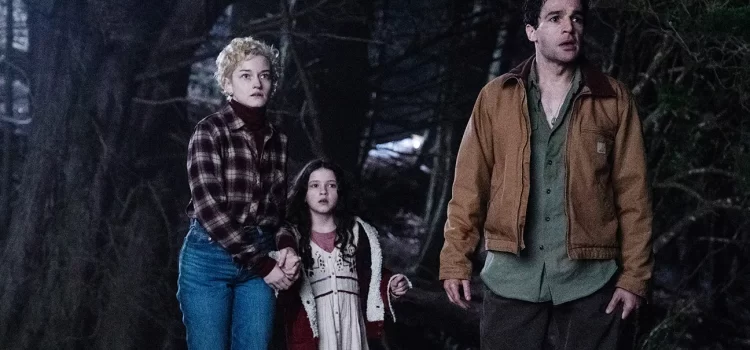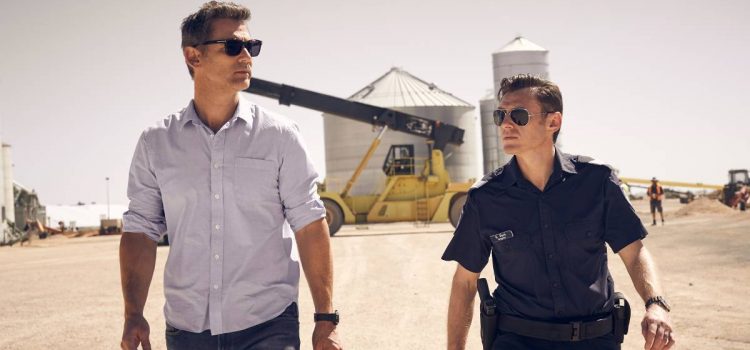By Alex McPherson
Efficient and stylistically engaging, if being neither especially scary nor emotionally involving, director Leigh Whannell’s “Wolf Man” is the embodiment of a serviceable horror flick— coasting along on atmospherics and gory set-pieces instead of fully chowing down on its themes.
We begin in 1995, where a young boy named Blake (Zac Chandler) lives with his survivalist father, Grady (Ben Prendergrast), on a farm nestled within a remote valley in west-central Oregon. Dad, a single, paranoid ex-Marine with a temper, runs a tight ship around the house; his over-protectiveness masks a deep-seated distrust and fear of the outside world.
One day while out hunting, Blake and Grady encounter a strange, frighteningly erratic humanoid creature weaving amongst the trees. They barely fend it off while holed up in a deer stand — a sequence greatly enhanced by the film’s enveloping sound design and camerawork; the threat could come at any time, from any angle. Could it be the hiker that recently went missing and is, allegedly, feral? Grady must find out.
Flash forward 30 years, and the all-grown-up Blake (Christopher Abbott), now an aimless writer in-between jobs, has moved from the Cascades to the Big Apple and started a family. He’s seemingly doing pretty well, but he’s going through a rough patch with his journalist wife, Charlotte (Julia Garner). Blake is very close with their young daughter, Ginger (Matilda Firth), but strains of his father’s toxicity shine through from time to time, an uneasy reminder of the mental scars Grady left on him.
Blake receives a letter in the mail notifying him of Grady’s passing, along with the keys to the farmhouse. Thinking that it could be a good opportunity to get away from the city and reconnect with his family, Blake, Charlotte, and Ginger take a roadtrip to the foreboding mountains.
It’s not exactly a relaxing vacation, though, as they soon encounter a creepy acquaintance from Blake’s childhood (Benedict Hardie) and, yes, that fuzzy-mugged humanoid beast from all those years ago. After causing Blake’s van to crash, the creature scratches Blake, later prompting Blake to undergo a gnarly metaphorical transformation in which he slowly but surely becomes the titular “Wolf Man.”
Whannell, a skilled filmmaker who previously directed such works as 2020’s deeply messed up “Invisible Man” remake and 2018’s underappreciated sci-fi gem, “Upgrade,” ensures that “Wolf Man” coasts along well enough on its jolt-heavy suspense and excellent sound design without impressing from a character standpoint.
Indeed, for all its effective scenes of cat-and-mouse suspense, “Wolf Man” can’t deliver on the emotional front. The seams of Whannell and Corbett Tuck’s screenplay show early on, where exposition dumps largely take the place of organically learning about who these characters are and what they’re striving towards.
The performances are merely fine. Abbott gets more to chew on than others, literally, as he embodies Blake’s gradual loss of faculties and humanity and visibly battles the disease that’s overtaking him, while Garner’s Charlotte is underwritten and mostly one-note. Firth fares better than some other child-actors-in-horror-movies as of late, but she can’t break free from the clunky confines of the screenplay.
It’s all quite programmatic. At the least the simple characterizations help make the film’s 103-minute runtime go at a fast clip; all the better that we get to the scares sooner.
These are Whannel’s forte, and he delivers the goods — creating a series of setups and payoffs that are more enjoyable than outright scary, playing with viewers’ expectations to catch us off guard (or at least attempt to), complete with suitably graphic makeup effects. Whannell and cinematographer Stefan Duscio make great use of the isolating landscape, peppered with trees, and Blake’s creaky farmhouse, keeping the focus tight on the characters as the events pass in real-time, largely over a single night.
The film’s outstanding sound design also does much of the heavy lifting throughout — especially strong during the tense opening sequence, and in visualizing the werewolf mutation directly through Blake’s eyes. Whannell shows the difference between reality and the warped distortions Blake experiences, often changing between them in the same shot; voices become muffled and faces turn barely recognizable. It’s neat, bringing to mind the sorts of cinematic tricks Whannell deployed in “Upgrade,” but remains more of a novelty, since “Wolf Man” doesn’t do enough early on to make us actually care.
While Whannell should be commended for tackling this Universal Monsters character with a different angle — veering away from the mysticism of its origins — and focusing on generational trauma and mental illness, “Wolf Man” feels half-baked. Whannell tries to be both fun and, by the end, weirdly sobering. This tonal mishmash doesn’t do the film any favors given itss sloppiness in scenes that aren’t focused on the immediate horror at play.
But “Wolf Man” was never trying to be groundbreaking. Watching in a theater is always the best option for movies, but, in this case, it’s the essential way to sink your teeth into this perfectly fine take on a horror legend.
“Wolf Man” is a 2025 horror movie directed by Leigh Whannell and starring Christopher Abbott and Julia Garner. It is rated R for bloody violent content, grisly images and some language and the run time is 1 hour, 43 minutes. It opened in theaters Jan. 17. Alex’s Grade: B-.

Alex McPherson is an unabashed pop culture nerd and a member of the St. Louis Film Critics Association.



